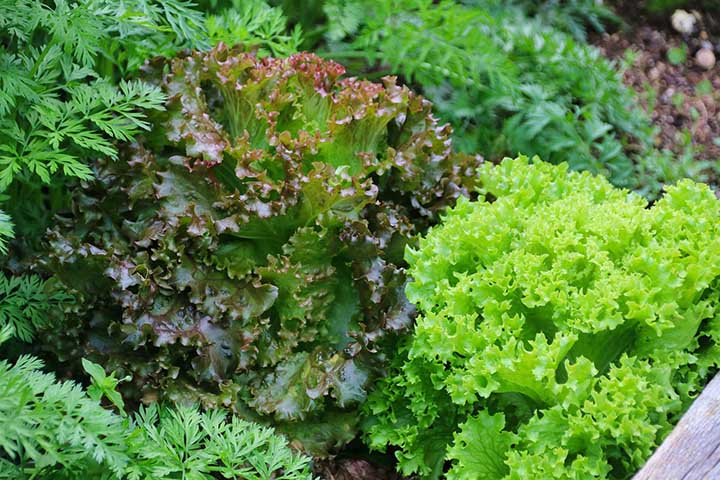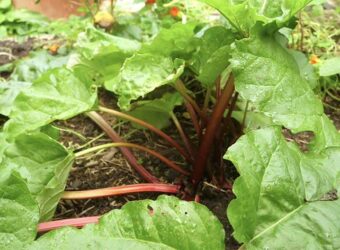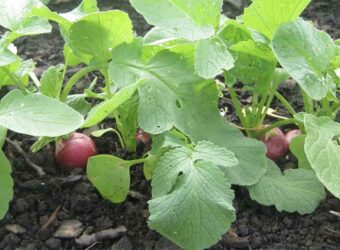Lettuce’s simple growth form and flexibility in the kitchen makes it a must-have garden crop. Another thing that’s great about lettuce is that it plays nicely with lots of other crops. By interplanting lettuce with other types of plants, you can increase soil diversity, attract beneficial insects, and help prevent disease.
Read on to learn more about some of the best (and worst) lettuce companion plants.
The 10 Best Companion Plants for Lettuce
If you’re looking for plants that can help lettuce grow well, you can choose from a variety of options. Check out these 10 best lettuce companion plants.
Tomatoes
Typically, lettuce is difficult to grow during the long, hot days of summer. This weather encourages them to send up flowers, aka bolt. When this happens, the leaves turn bitter and unpalatable.
However, providing a bit of shade can help keep lettuce plants continue to grow well as days become hot. Since tomato plants are tall, they can provide helpful shade to lettuce plants.
If you have a row of tomato plants, try planting lettuce about a foot away from the tomatoes on the eastern side of the row. This way, the tomatoes will provide shade from the harsh afternoon sun.
You can also try tucking lettuce plants in between tomato plants. If you do this, make sure to prune lower tomato leaves to allow airflow and prevent disease.
As tomatoes provide shade for the lettuce plants, the lettuces also help hold in soil moisture and prevent weeds.
Radishes
Radishes are some of the quickest-growing crops, which means they’re easy to sneak in with other vegetables like lettuce.
If you plant lettuce transplants, you can expect to harvest them 60 to 80 days after planting. Rather than wasting the space between small lettuce plants, you can plant radishes in this empty space.
Small radish varieties mature in three to four weeks. Therefore, you can harvest the radishes just as the lettuce plants are beginning to crowd them out.
Sweet Alyssum
While lettuce is immune from some insects, it can still be attacked by cabbage loopers, cutworms, armyworms, slugs, and other munching pests. If you want to keep these pests in check without the use of pesticides, try planting sweet alyssum.
This flowering plant produces hundreds of tiny flowers that attract beneficial insects. These insects feed on the nectar and pollen that sweet alyssum produces.
Ladybug larvae and adults consume aphids, which can be a major lettuce pest. However, the adults also eat nectar and pollen. This means planting sweet alyssum will help keep them around when aphid populations are low.
Sweet alyssum can also attract small bee-like flies known as hoverflies. While the adults feed on nectar, the larvae consume lettuce pests including aphids, thrips, and caterpillars.
These flowering plants only reach six inches tall, so you can easily tuck a plant or two among your lettuce plants.
Chives
Aphids are one of the biggest pests of lettuce plants. These tiny sap-sucking insects can quickly overtake a lettuce plant, and cause discoloration or even death.
One way to deter aphids from feeding on your lettuce plants is to plant chives nearby. This allium herb may help keep some types of aphids at bay.
With that said, chives won’t fully prevent aphid outbreaks. Providing the proper soil nutrients, spacing your lettuce at the right distance, and treating pests are all key steps to preventing aphids from destroying your lettuce plants.
As far as plant spacing goes, remember that chives are a cut-and-come-again crop. This means they will continue growing after you harvest them.
With that in mind, make sure lettuce plants will not overtake the chives as they grow. Try planting two rows of lettuce 1416” apart with a row of chives in the middle.
Scallions
Also known as green onions, scallions are another great companion plant for lettuce. Like chives, they are members of the allium family.
This means they may help keep some harmful insects at bay.
Scallions also fit in well with lettuce since both crops mature at similar rates. This means you can tuck lettuce and scallions in the same area of your garden, and then harvest them at the same time.
After you harvest the crops, you’ll be left with an empty area that you can replant.
Beets
While beets and lettuce are both shallow-rooted crops, they can grow together nicely. Planting a row of beet between a row of lettuce provides plant diversity, which can help improve soil life.
As beets grow, their greens provide shade to maturing lettuce plants. And if you plant beets and lettuce at the same time, the beets will be ready to harvest a few weeks before the lettuce.
Once you pull the beets from the ground, the lettuce will have extra space to finish maturing.
Carrots
Carrots are another root crop that grows well with lettuce. Carrots grow up and down rather than out, which means they fit well between lettuce heads.
Additionally, lettuce plants are shallow-rooted, which means they obtain water and nutrients from the top few inches of soil. Carrots on the other hand have deeper roots that allow them to absorb water and nutrients from a different part of the soil.
Carrots and lettuce also mature in approximately the same length of time, which means you can harvest both together. This provides a blank slate for you to replant.
Peas
Lettuce and peas both prefer cool growing conditions which makes them a natural pair.
Peas also ‘fix’ nitrogen, meaning they turn atmospheric nitrogen into a form that is available for plant uptake. This helps enrich the soil with nitrogen that lettuce needs to grow.
If you’re planting these two crops together, it’s important to trellis your peas so they don’t overtake the lettuce. You can then plant your lettuce a foot away from the base of your pea plants.
Peppers
Another warm-weather crop that grows well with lettuce is peppers. Since pepper plants grow a few feet tall, they can provide helpful shade to lettuce plants.
Try tucking lettuce plants on the east side of pepper plants to protect them from the intense afternoon sun.
Eggplant
Eggplants also grow in the summer. Therefore, they can be used as a natural shade source for lettuce plants.
If you are growing a few eggplant plants, you can plant lettuce plants in the middle of the plants. Alternatively, you can place plants about a foot away from the base of an individual plant.
The 5 Worst Companion Plants for Lettuce
While many crops are good companion plants for lettuce, you should avoid planting these crops next to lettuce.
Cucumber
Cucumbers are sprawling plants that can quickly take over an area. If you plant them beside lettuce plants–or even a few feet away–they will likely grow over your lettuce plants.
Therefore, cucumber plants are best kept in an area where they have multiple feet of room to sprawl.
However, if you trellis your cucumber plants, you may be able to plant lettuce next to them. In this case, plant lettuce a few feet away from the base of the plants.
Winter Squash
Winter squash such as butternut and pumpkins also grow in a trailing habit. In fact, healthy plants can produce vines that are over 15 feet long!
As you can imagine, these plants take up a lot of space. And they don’t care what they grow on top of.
If you plant lettuce near winter squash plants, they are likely to be taken over by the vining crops. Therefore, you should keep winter squash away from delicate and low-growing lettuce plants.
Melons
Another trailing plant! Melons including watermelon, cantaloupe, and muskmelon also send out long vines that can engulf lettuce plants.
With this in mind, you should avoid planting lettuce near melons.
Sweet Potatoes
Another crop you should not plant next to lettuce is sweet potatoes. While these sugary tubers are delicious, they require space of their own!
While most people know sweet potatoes for their orange tubers, the plants also produce sprawling above-ground vines. These quick-growing vines can take over any lettuce plants before they have time to mature.
Broccoli
While you can plant lettuce next to broccoli, these two crops aren’t the most compatible. While broccoli plants start small, they quickly grow into plants that are multiple feet in diameter.
This size means that broccoli provides shade, but it often tends to be too much shade. If broccoli leaves cover lettuce plants entirely, the lettuce doesn’t receive the light it needs to grow.
Broccoli and lettuce plants also require a fair bit of nitrogen, so the plants may compete for nutrients.
Benefits of Companion Plants for Lettuce
Why should you think about companion plants with your lettuce? The benefits, of course!
Using companion plants with lettuce can extend the growing season, help lettuce fend off pests, and more.
Extend the Growing Season
Lettuce is known for being notoriously sensitive to heat. If you’ve ever puckered your face after picking your greens or watched a lettuce plant turn into a tall flower-filled tree, you know what I’m talking about.
Yet summer’s heat—and the lazy feeling that comes with it—brings cravings for crisp and easy salads.
Planting taller plants next to lettuce can provide a bit of shade, which allows you to grow lettuce into the hotter months.
That said, don’t just plant a tall plant next to your lettuce and assume it will thrive during 90⁰F days. You’ll also need to provide the plants with adequate moisture and choose heat-resistant varieties (Muir and Cherokee are some of my favorites).
Control Common Pests
Some of the most common pests for lettuce include sap-sucking insects like aphids, thrips, and whiteflies. These little critters use their piercing-sucking mouthparts to drink up the lettuce plant’s sap.
When lots of these pests attack lettuce, the plants can become discolored, weak, and stunted. However, a few pests generally won’t do much damage.
The good news is that beneficial insects like lady beetles, green lacewings, midges, and parasitic wasps feed on these pests and help keep them in check. That means your lettuce plants can thrive, and you can avoid the work of controlling sap-sucking pests through chemical means.
One key part of keeping these beneficial insects around is providing food for all of their life stages. While green lacewing and parasitic wasp larvae are voracious predators, the adults mainly eat flower nectar and pollen.
That means that planting flowering plants amongst your lettuce will help keep these good insects around.
Enrich the Soil
Like all plants, lettuce needs a variety of nutrients to thrive. And nitrogen is one of the nutrients it needs a lot of.
While you can add fertilizer to increase the amount of nitrogen in the soil, you can also turn to specific plants. Legumes such as peas and beans ‘fix’ nitrogen from the atmosphere and add it to the soil.
If you’re thinking, “that’s pretty cool,” you’re right! So, how exactly do these plants do it?
Legumes’ roots have nodules that contain bacteria in the Rhizobium genus. This bacteria converts atmospheric nitrogen (N₂) to ammonium (NH₄), which plants are able to take up.
Conserve Soil Moisture
Since companion plants can provide a bit of shade, they can also help conserve soil moisture. This benefits lettuce plants since these leafy greens struggle when the soil dries out.
When you plant companion plants with your lettuce, you will likely need to water less often than if you planted your lettuce alone.






